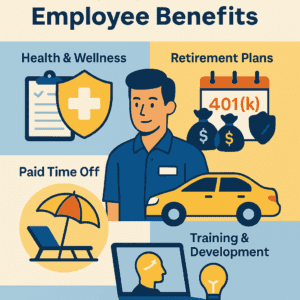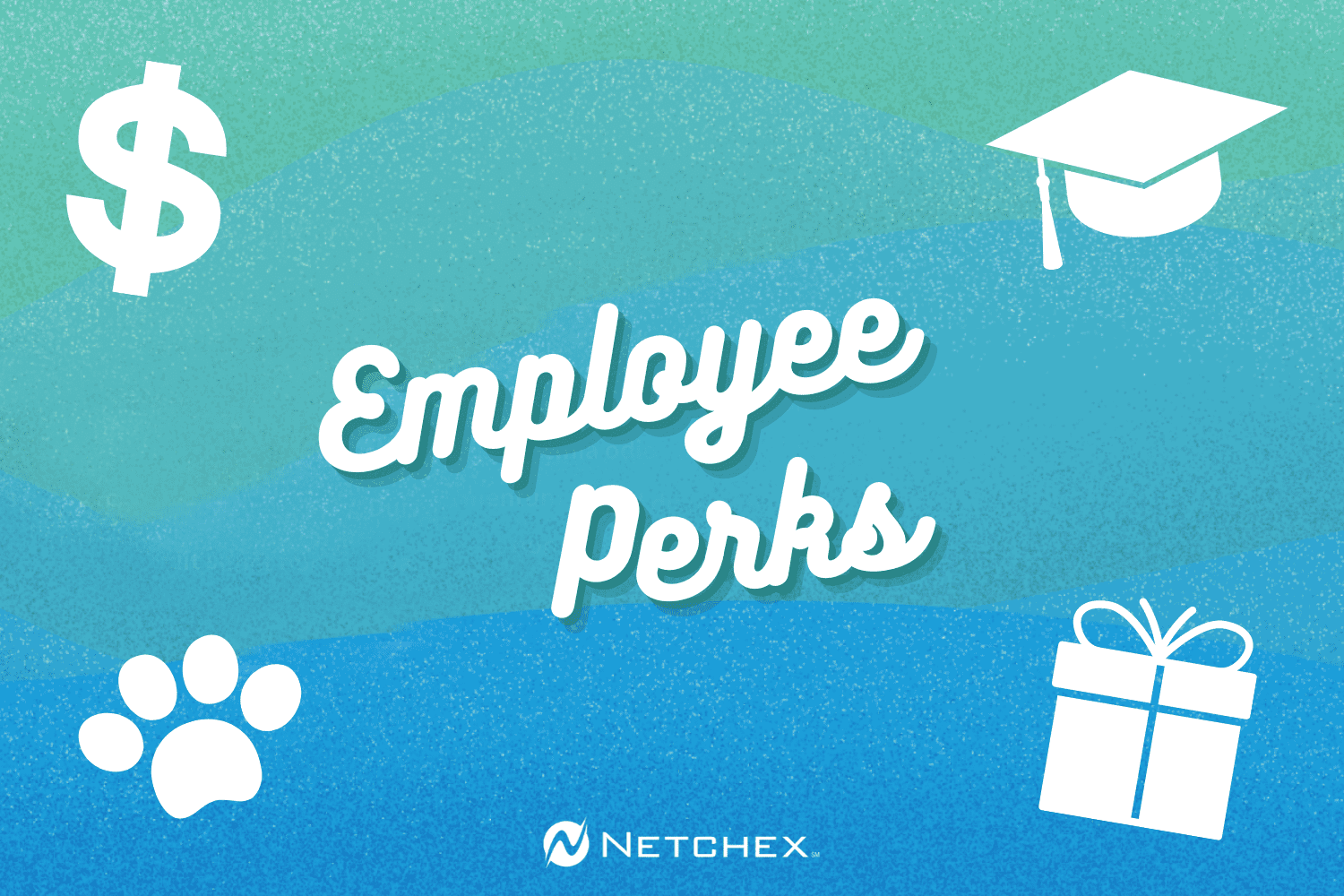Share
In today’s highly competitive recruiting market, employee benefits and perks give your company an edge over the competition. These details, especially employee perks, are a major influence on where job searchers end up applying and working.
But what is the difference between employee benefits and perks? Why should you offer both, instead of just one or the other. And finally, what emerging employee perks should your company consider offering in order to stay ahead of the curve.
What is the difference between employee perks and benefits?
Generally considered part of an employee’s compensation package, employee benefits include things like health insurance and retirement savings.
Also known as fringe benefits, employee perks are more like bonus incentives, like an on-site gym and student loan reimbursement. Employee perks tend to be less expensive for the employer, but benefits may be more vital to employees.
Why offer additional employee perks in addition to benefits?
Since employee perks aren’t legally required or even expected by most workers, why bother with the added expense? Even if it’s hard to quantify the ROI, perks help your business stand out from the competition, especially when it comes to rewarding loyal employees.
Recruiting
If your own company’s wages look pretty similar to the competition, then why should new job applicants choose you? When wages and other factors are comparable, employee perks can attract top talent.
Retention
Employees become accustomed to the employee perks of having specific perks—from on-site gyms to daycare. Other employers may always offer your workers financial incentives to leave, but perks give your workers a good reason to stay with your team.
Employee well-being
Some perks make a big difference for employees, especially when you use the company’s buying power to secure in-demand services like mental health and daycare. Some employee perks make a huge difference without requiring a big financial commitment from the employer.
Five employee benefits you should already provide
Some benefits are legally required in certain industries. For example, if your company has more than 50 full-time employees, then you’re required by the Affordable Care Act (ACA) to provide healthcare coverage.
Health insurance
Health insurance was already a standard job benefit before the ACA, but now it’s more likely to be mandatory. Dental and vision insurance policies may be optional add-ons.
Life insurance
Life insurance provides peace of mind for employees with dependents and families. Funerals and burials are expensive, and surviving family members may struggle financially because of the lost income.
Paid time off
Reduce burnout by encouraging employees to take advantage of PTO. Paid sick days allow workers to avoid spreading anything contagious around the office. Special features of scheduling software include portals for workers to request leave and swap shifts.
Family leave
Parents of youngsters cannot leave sick children at home alone, and other workers may sometimes need to care for aging parents. The Family Medical Leave Act (FMLA) has minimum requirements for unpaid leave.
READ: Seven HR Tips for Better Leave Management Policy
Retirement planning
Consider matching employee contributions to their retirement savings. Workers actively saving for retirement are less likely to treat their job at your company as a short term gig.
15 emerging employee perks to consider
Employee perks allow your company to invest in employees without a huge financial expense. New and emerging perks let your company get creative in supporting staff.
Flexible schedules and remote work
This can mean lots of different things—late mornings, early departure, half-day Fridays, etc. While still getting 40 hours/week, this allows workers more flexibility and better work-life balance. For job searchers, this little employee perk is a big improvement over the weekly grind.
DISCOVER: What Is ‘Windowed Work’ and Why It Could Be the Key to Your Success
How about transitioning to more hybrid and remote positions for the long term? Unlimited Paid Time Off is a recent trend, mostly applicable for salary workers, and it reduces the paperwork of tracking the accrual of unused time.
Floating holidays
Instead of choosing between what smaller holidays to give off, why not let employees choose which holidays they prefer? A quarterly “skip day” encourages employees to use PTO for mental health breaks instead of primarily responding to illness and family crises. What if employees got a day off for their birthday or employment anniversary?
Continuing education
Use a Learning Management System like NetLearn to empower and encourage extra training and upskilling. Cross-train employees in parallel tracks for a more flexible workforce. Use reskilling for positions and departments that have become less important, helping workers prepare for new and changing roles.
DISCOVER: Seven Reasons Why You Need a Learning Management System
Student loan reimbursement
Student loans are a huge financial burden for young professionals. Reducing and eliminating debt may be a higher priority than retirement savings, and your company can help workers tackle those personal financial goals.
Financial planning and education
Many workers, especially those young and new to adulthood, could use help managing their income wisely. Help with financial education to guide employees through their many choices, whether they want to invest in their career or save for their children’s education.
Child care
Trustworthy child care is hard to find—and expensive. Parents of young children may decide that one parent needs to stay home and sideline professional goals, simply because of the limited availability and/or cost of child care. On-site child care provides additional peace of mind and convenience, but vouchers and discounts for off-site child care will also be appreciated.
READ: How Can HR Help Support and Retain Working Mothers?
Wellness programs
If your workforce includes drivers, warehouse workers, and others who perform physical labor, then you know how much physical health matters. Office workers with a sedentary lifestyle have their own range of health risks. Get proactive with in-office health screenings and education. Address both physical and mental health by connecting with local therapists, nutritionists, and other resources.
LEARN: 5 Tips to Support Employee Mental Health in the Workplace
Gym membership
An on-site gym isn’t possible at every office, but you can still offer memberships and discounts at area gyms. Consider the locations and equipment available at different facilities, including group classes and other services.
Discounts and corporate rates
Corporate discounts can reduce the cost of all kinds of services—both locally and nationwide. Use NetPerks to access savings on movie tickets, family vacations, bulk groceries, and more.

Employee recognition and awards
Recognition and awards are affordable ways to recognize outstanding service and achievement. Celebrate years of employment as well as high performance.
Paid volunteer days and charitable matching
Support community nonprofits to help foster teamwork and a sense of purpose. Use a charitable giving program like Helping Hands to manage workplace giving for a worthy cause.
Pet insurance and pet-friendly office
Most of your workers have very big feelings about their pets, especially since the pandemic. Having a pet-friendly office can help ease the concerns of office re-entry. Additionally, pet insurance can reduce the burden of veterinary expenses.
Commuter benefits
Depending on your office location, parking and gas reimbursement can help workers commuting in their own vehicle. Larger cities may have opportunities for your company to support cyclists and carpoolers.
Meal reimbursement and/or free food
Cynics in your office may say “there’s no such thing as free lunch,” but it will be harder to hear complaints while they’re chowing down on free sandwiches. Occasional catered meals and treats are effective ways to boost morale.
Music/podcast streaming membership
Some employees find music and audio entertainment are great for focus while working. On the other hand, help others relax and unwind with premium streaming content.
Learn more about Netchex’s Employee Perks and Benefits Management software:
Learn more about our Benefits Administration software, where comprehensive doesn’t have to mean complex. Netchex makes Benefits Administration (and employee perks!) easy, straightforward, and worry-free.
Industry news & tips sent straight to your inbox!
Enter your email below to subscribe to industry news, product updates, and tips.
For more information on HR topics, read our HR blog and follow Netchex on social media—Facebook, LinkedIn, and Twitter.
Related articles

How to Improve Your Open Enrollment Communications in 2025?

Payroll & Benefits Compliance: A No-Panic Playbook for HR Teams

Benefits Administration

